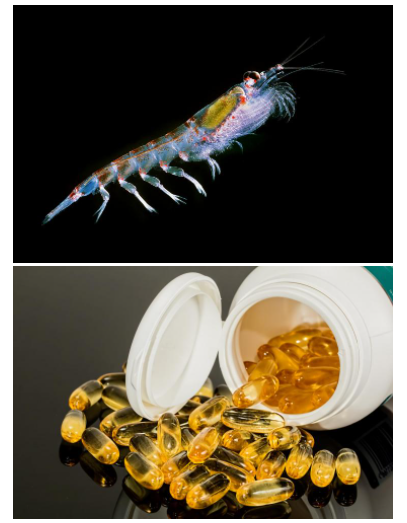Jun 16 2021
Krill populations in the core of their Antarctic habitat are expected to drop by 30% this century as a result of extensive negative impacts of human-induced climate change.
 Top: Antarctic krill Euphausia superba. Image Credit: Uwe Kils/Wikipedia. Bottom: Omega-3 oil pills, the product of a booming $2 billion fish oil industry. Image Credit: PxHere.
Top: Antarctic krill Euphausia superba. Image Credit: Uwe Kils/Wikipedia. Bottom: Omega-3 oil pills, the product of a booming $2 billion fish oil industry. Image Credit: PxHere.
According to a new study performed by the University of Colorado at Boulder (Cu Boulder), the effects of human-driven climate change on this tiny yet important species will be mostly indistinguishable from natural changes in the region’s climate until late in the 21st century.
The study, recently published in the Frontiers in Marine Science journal, holds major implications not just for the local food web but also for the biggest commercial fishery in the Southern Ocean: a thriving $2 billion fish oil industry, marketed as Omega-3 supplements at retail giants, such as Costco.
Krill are what links the ecosystem together. They’re really important to the Southern Ocean for pretty much every predator species.
Zephyr Sylvester, Study Lead Author and Graduate Student in Environmental Studies, University of Colorado at Boulder
Since these small creatures reside in one of the world’s most vulnerable places in regard to climate change, clearly distinguishing the trends related to human-driven warming from those emerging naturally in krill habitat is a critical step in planning and plotting harvest limits.
This is also the first study of its kind to utilize a set of climate models to show that while climate change has the ability to substantially modify the Antarctic marine ecosystems, natural climate changes can conceal human-driven trends.
Small but Significant
Krill are fast-swimming zooplankton that grow to be approximately 2.5 inches (6 cm) long and dwell in big groups. They are essential to the region’s food chain and are consumed by almost everything that lives in the seas surrounding Antarctica, including whales, penguins, fish and seals, a few of which are still recovering from overharvesting in earlier centuries.
However, while Krill are one of the most abundant creatures on the planet with a total biomass estimated to be 300 to 500 million tons, they can only live in a restricted temperature range and are largely affected by changes in their underwater habitat.
At present, fishing in the Southern Ocean is controlled by the Convention on the Conservation of Antarctic Marine Living Resources or CCAMLR for short. This international organization was formed as part of the Antarctic Treaty System.
Krill is the first thing on the researchers’ agenda. But four decades after they were founded, the team’s catch limits on these species are still set using only a stock assessment that does not consider the variability of the natural environment or the effects of climate change.
Today, there is an extensive universal recognition of the significance of knowing the effects of climate change on this marine ecosystem, but understanding how the climate naturally changes is a crucial prerequisite, as stated by Sylvester.
The thing that we really have to understand is: Is there enough krill to feed everything that needs to eat it in the Southern Ocean, as well as humans? My hope is that we can take this as a first step to understanding how to manage krill better.
Cassandra Brooks, Study Co-Author and Assistant Professor, Environmental Studies, University of Colorado at Boulder
What is Natural Variability?
Each environment on the planet naturally changes in terms of temperature, weather and precipitation throughout the year. In Colorado, for example, some winters have more snowfall than others. Some winters will be slightly warmer, while others will be cooler. Apart from man-made climate change, a distinct pattern of temperature and precipitation caused by natural variability occurs in the state every year.
However, isolating the impacts of human-driven climate change from natural changes in a certain place is a difficult process. The researchers ran a bigger group of models, called a large ensemble earth system model, several times to separate the variables impacting the Southern Ocean over the next century. It is the first time that this has been done for krill and for the Southern Ocean.
Then we were able to look at the different trends and quantify how much the natural variability was masking the signal for climate change.
Zephyr Sylvester, Study Lead Author and Graduate Student, Environmental Studies, University of Colorado at Boulder
This study tackles one of the most significant gaps between fishery managers and scientists: that is, interpreting and conveying uncertainty. According to Brooks, the ability to measure the amount of change that is expected to occur from natural variability, and independently from climate change, will allow everyone involved to plan better in the days to come and preserve the krill for those who rely on it.
“Even if we won't see this really strong signal from climate change until later, what's important for us to understand is that the Southern Ocean is a very dynamic system and we absolutely have to be managing for natural variability. And we should be ready to manage for the broader impacts of climate change,” concluded Brooks.
Journal Reference:
Sylvester, Z. T., et al. (2021) Detecting Climate Signals in Southern Ocean Krill Growth Habitat. Frontiers in Marine Science. doi.org/10.3389/fmars.2021.669508.